HR Practices Impact on Employee Retention: Qatar's F&B Industry Study
VerifiedAdded on 2023/06/10
|24
|6474
|111
Project
AI Summary
This research project investigates the impact of HR practices on employee retention within Qatar's Food and Beverage industry, addressing critical issues like cost implications and managing business performance related to employee turnover. The study aims to identify the top five reasons for employee turnover in casual dining restaurants in Qatar, assess the balance between employee retention and organizational profitability, and determine the best HR practices for enhancing retention rates. The research questions are designed to explore factors such as affective forces, constituent forces, alternative forces, and job dissatisfaction, while considering the influence of effective communication, decentralization, career development, and training. The project employs primary data collection, focusing on the perceptions of employees who have left their jobs, and acknowledges limitations related to the absence of secondary research and the specific focus on Qatar's F&B industry. The academic relevance is established through a review of literature on employee turnover, organizational profitability, and employee retention practices, ensuring the reliability and practical relevance of the research outcomes.
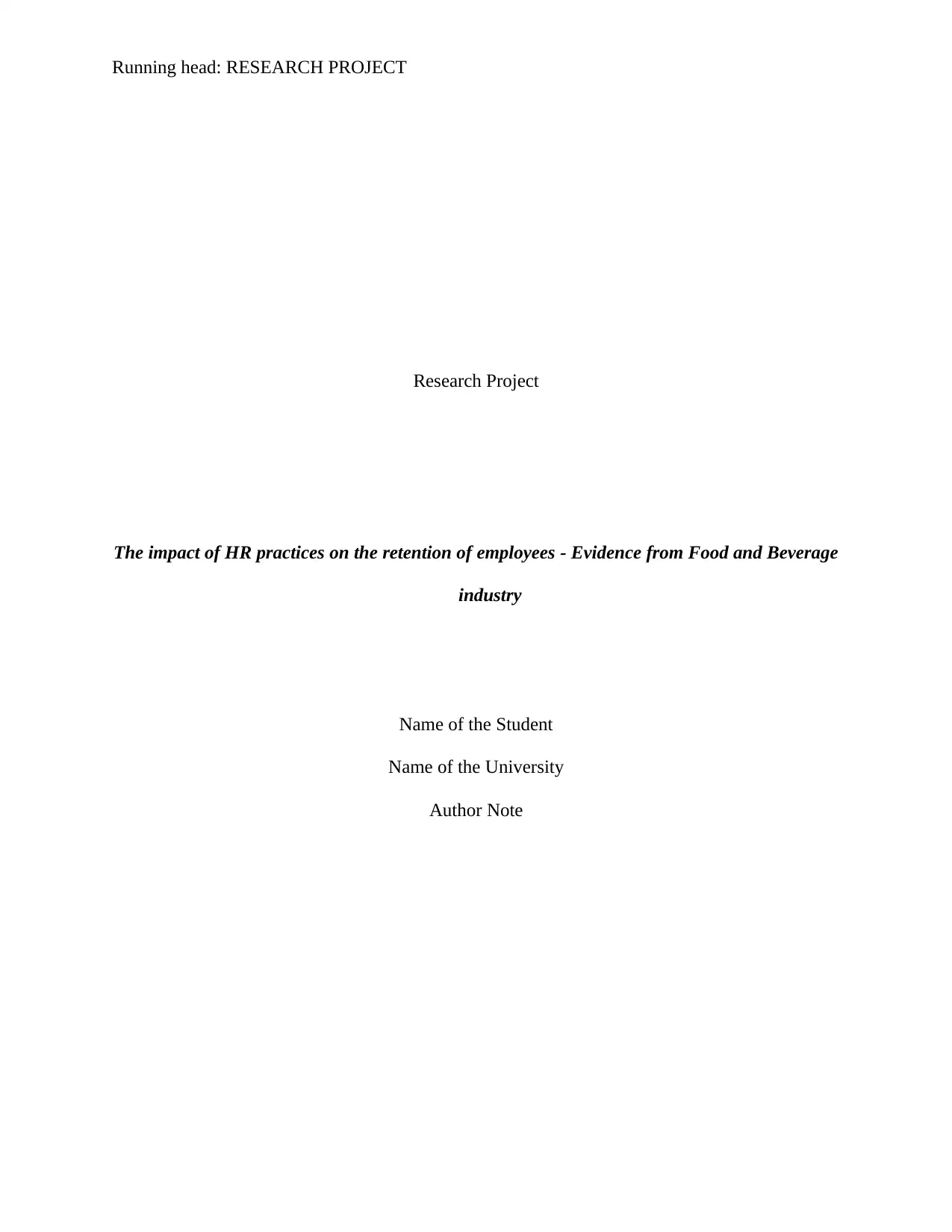
Running head: RESEARCH PROJECT
Research Project
The impact of HR practices on the retention of employees - Evidence from Food and Beverage
industry
Name of the Student
Name of the University
Author Note
Research Project
The impact of HR practices on the retention of employees - Evidence from Food and Beverage
industry
Name of the Student
Name of the University
Author Note
Paraphrase This Document
Need a fresh take? Get an instant paraphrase of this document with our AI Paraphraser
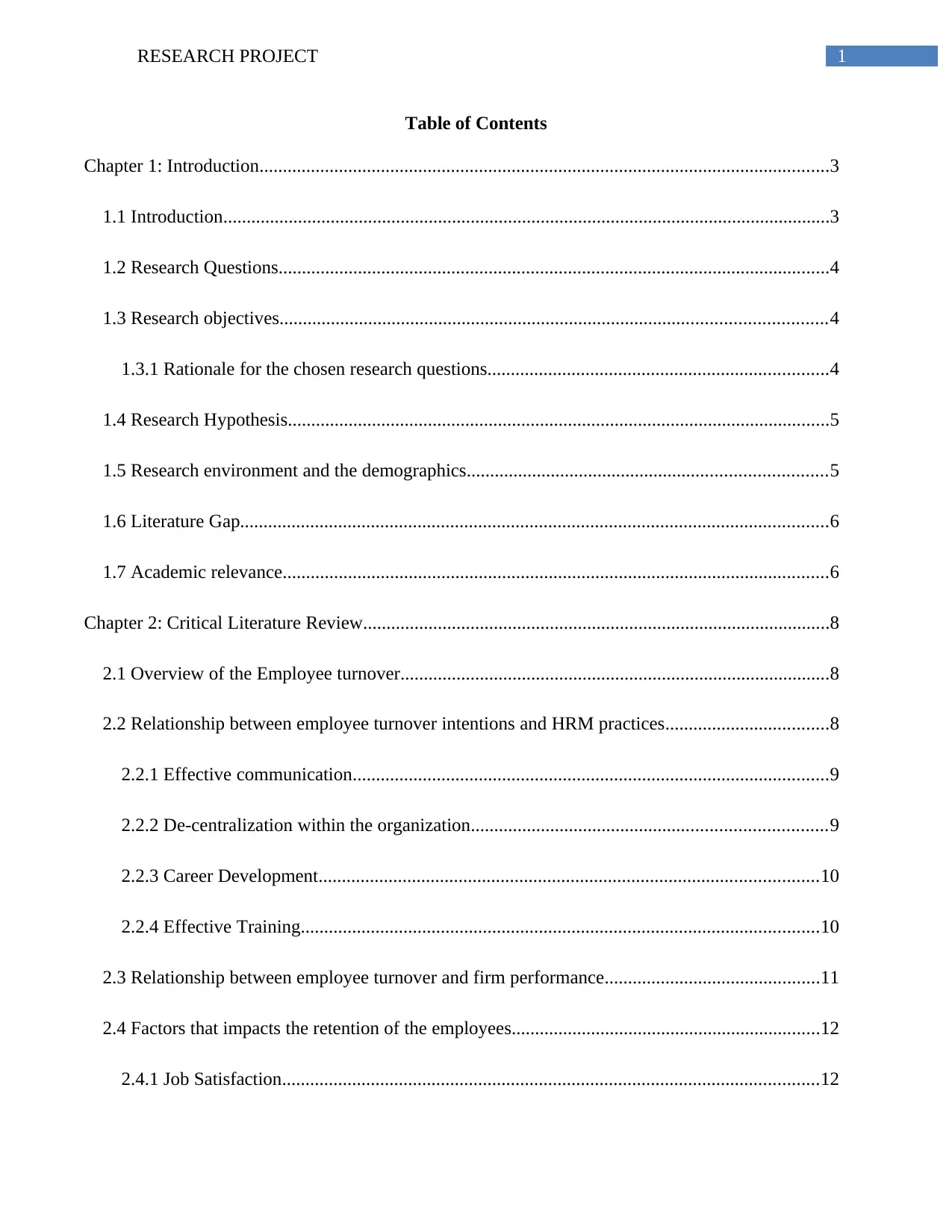
1RESEARCH PROJECT
Table of Contents
Chapter 1: Introduction..........................................................................................................................3
1.1 Introduction..................................................................................................................................3
1.2 Research Questions......................................................................................................................4
1.3 Research objectives.....................................................................................................................4
1.3.1 Rationale for the chosen research questions.........................................................................4
1.4 Research Hypothesis....................................................................................................................5
1.5 Research environment and the demographics.............................................................................5
1.6 Literature Gap..............................................................................................................................6
1.7 Academic relevance.....................................................................................................................6
Chapter 2: Critical Literature Review....................................................................................................8
2.1 Overview of the Employee turnover............................................................................................8
2.2 Relationship between employee turnover intentions and HRM practices...................................8
2.2.1 Effective communication......................................................................................................9
2.2.2 De-centralization within the organization............................................................................9
2.2.3 Career Development...........................................................................................................10
2.2.4 Effective Training...............................................................................................................10
2.3 Relationship between employee turnover and firm performance..............................................11
2.4 Factors that impacts the retention of the employees..................................................................12
2.4.1 Job Satisfaction...................................................................................................................12
Table of Contents
Chapter 1: Introduction..........................................................................................................................3
1.1 Introduction..................................................................................................................................3
1.2 Research Questions......................................................................................................................4
1.3 Research objectives.....................................................................................................................4
1.3.1 Rationale for the chosen research questions.........................................................................4
1.4 Research Hypothesis....................................................................................................................5
1.5 Research environment and the demographics.............................................................................5
1.6 Literature Gap..............................................................................................................................6
1.7 Academic relevance.....................................................................................................................6
Chapter 2: Critical Literature Review....................................................................................................8
2.1 Overview of the Employee turnover............................................................................................8
2.2 Relationship between employee turnover intentions and HRM practices...................................8
2.2.1 Effective communication......................................................................................................9
2.2.2 De-centralization within the organization............................................................................9
2.2.3 Career Development...........................................................................................................10
2.2.4 Effective Training...............................................................................................................10
2.3 Relationship between employee turnover and firm performance..............................................11
2.4 Factors that impacts the retention of the employees..................................................................12
2.4.1 Job Satisfaction...................................................................................................................12
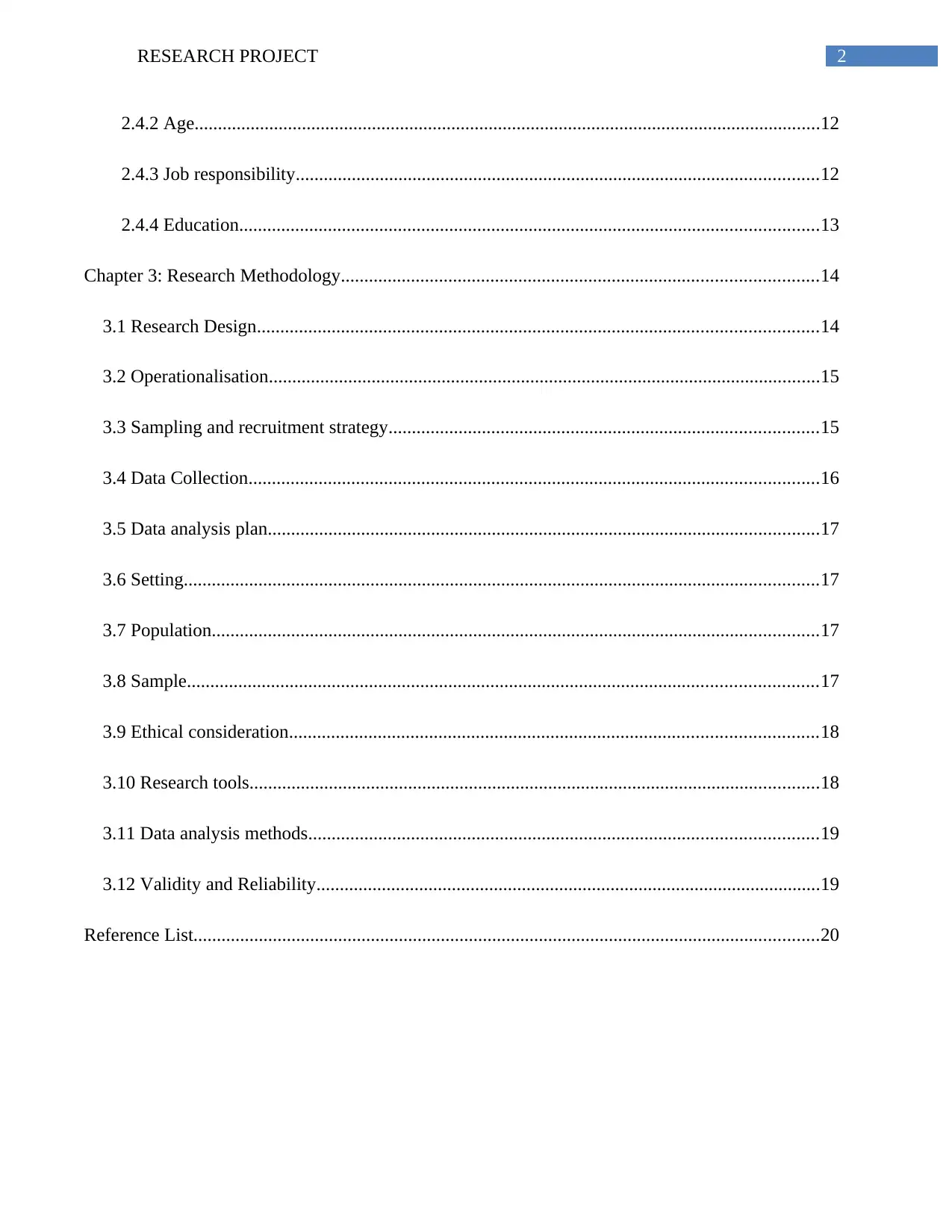
2RESEARCH PROJECT
2.4.2 Age......................................................................................................................................12
2.4.3 Job responsibility................................................................................................................12
2.4.4 Education............................................................................................................................13
Chapter 3: Research Methodology......................................................................................................14
3.1 Research Design........................................................................................................................14
3.2 Operationalisation......................................................................................................................15
3.3 Sampling and recruitment strategy............................................................................................15
3.4 Data Collection..........................................................................................................................16
3.5 Data analysis plan......................................................................................................................17
3.6 Setting........................................................................................................................................17
3.7 Population..................................................................................................................................17
3.8 Sample.......................................................................................................................................17
3.9 Ethical consideration.................................................................................................................18
3.10 Research tools..........................................................................................................................18
3.11 Data analysis methods.............................................................................................................19
3.12 Validity and Reliability............................................................................................................19
Reference List......................................................................................................................................20
2.4.2 Age......................................................................................................................................12
2.4.3 Job responsibility................................................................................................................12
2.4.4 Education............................................................................................................................13
Chapter 3: Research Methodology......................................................................................................14
3.1 Research Design........................................................................................................................14
3.2 Operationalisation......................................................................................................................15
3.3 Sampling and recruitment strategy............................................................................................15
3.4 Data Collection..........................................................................................................................16
3.5 Data analysis plan......................................................................................................................17
3.6 Setting........................................................................................................................................17
3.7 Population..................................................................................................................................17
3.8 Sample.......................................................................................................................................17
3.9 Ethical consideration.................................................................................................................18
3.10 Research tools..........................................................................................................................18
3.11 Data analysis methods.............................................................................................................19
3.12 Validity and Reliability............................................................................................................19
Reference List......................................................................................................................................20
⊘ This is a preview!⊘
Do you want full access?
Subscribe today to unlock all pages.

Trusted by 1+ million students worldwide
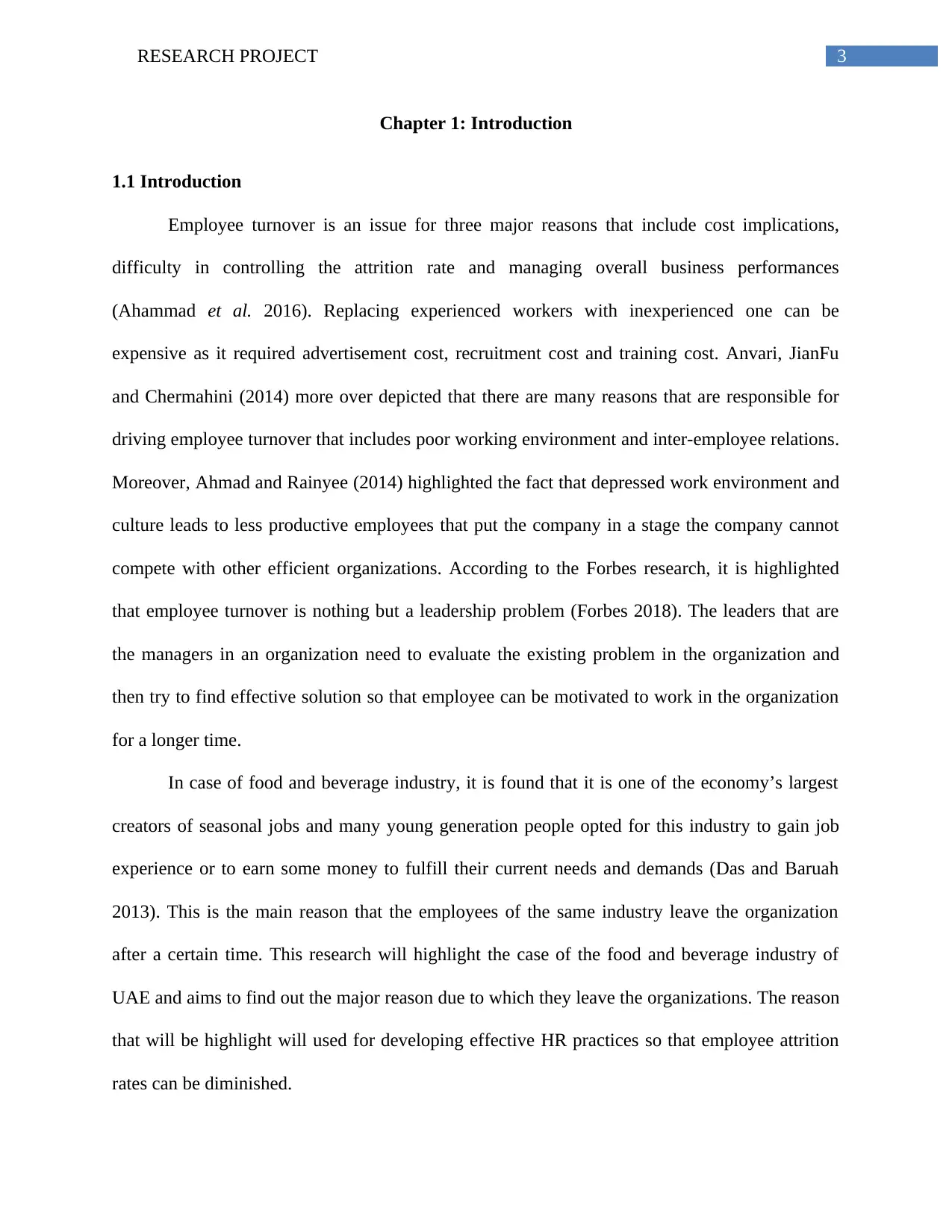
3RESEARCH PROJECT
Chapter 1: Introduction
1.1 Introduction
Employee turnover is an issue for three major reasons that include cost implications,
difficulty in controlling the attrition rate and managing overall business performances
(Ahammad et al. 2016). Replacing experienced workers with inexperienced one can be
expensive as it required advertisement cost, recruitment cost and training cost. Anvari, JianFu
and Chermahini (2014) more over depicted that there are many reasons that are responsible for
driving employee turnover that includes poor working environment and inter-employee relations.
Moreover, Ahmad and Rainyee (2014) highlighted the fact that depressed work environment and
culture leads to less productive employees that put the company in a stage the company cannot
compete with other efficient organizations. According to the Forbes research, it is highlighted
that employee turnover is nothing but a leadership problem (Forbes 2018). The leaders that are
the managers in an organization need to evaluate the existing problem in the organization and
then try to find effective solution so that employee can be motivated to work in the organization
for a longer time.
In case of food and beverage industry, it is found that it is one of the economy’s largest
creators of seasonal jobs and many young generation people opted for this industry to gain job
experience or to earn some money to fulfill their current needs and demands (Das and Baruah
2013). This is the main reason that the employees of the same industry leave the organization
after a certain time. This research will highlight the case of the food and beverage industry of
UAE and aims to find out the major reason due to which they leave the organizations. The reason
that will be highlight will used for developing effective HR practices so that employee attrition
rates can be diminished.
Chapter 1: Introduction
1.1 Introduction
Employee turnover is an issue for three major reasons that include cost implications,
difficulty in controlling the attrition rate and managing overall business performances
(Ahammad et al. 2016). Replacing experienced workers with inexperienced one can be
expensive as it required advertisement cost, recruitment cost and training cost. Anvari, JianFu
and Chermahini (2014) more over depicted that there are many reasons that are responsible for
driving employee turnover that includes poor working environment and inter-employee relations.
Moreover, Ahmad and Rainyee (2014) highlighted the fact that depressed work environment and
culture leads to less productive employees that put the company in a stage the company cannot
compete with other efficient organizations. According to the Forbes research, it is highlighted
that employee turnover is nothing but a leadership problem (Forbes 2018). The leaders that are
the managers in an organization need to evaluate the existing problem in the organization and
then try to find effective solution so that employee can be motivated to work in the organization
for a longer time.
In case of food and beverage industry, it is found that it is one of the economy’s largest
creators of seasonal jobs and many young generation people opted for this industry to gain job
experience or to earn some money to fulfill their current needs and demands (Das and Baruah
2013). This is the main reason that the employees of the same industry leave the organization
after a certain time. This research will highlight the case of the food and beverage industry of
UAE and aims to find out the major reason due to which they leave the organizations. The reason
that will be highlight will used for developing effective HR practices so that employee attrition
rates can be diminished.
Paraphrase This Document
Need a fresh take? Get an instant paraphrase of this document with our AI Paraphraser
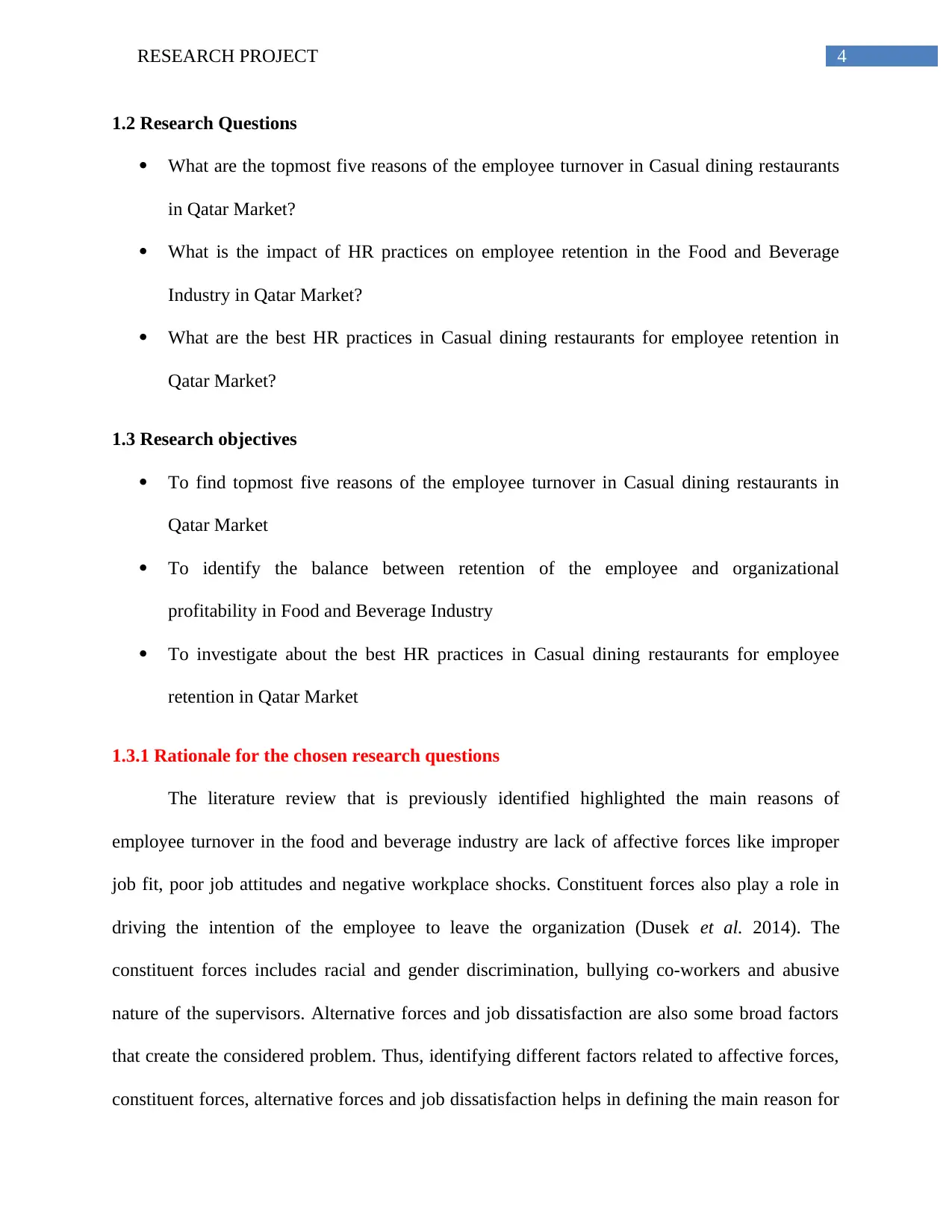
4RESEARCH PROJECT
1.2 Research Questions
What are the topmost five reasons of the employee turnover in Casual dining restaurants
in Qatar Market?
What is the impact of HR practices on employee retention in the Food and Beverage
Industry in Qatar Market?
What are the best HR practices in Casual dining restaurants for employee retention in
Qatar Market?
1.3 Research objectives
To find topmost five reasons of the employee turnover in Casual dining restaurants in
Qatar Market
To identify the balance between retention of the employee and organizational
profitability in Food and Beverage Industry
To investigate about the best HR practices in Casual dining restaurants for employee
retention in Qatar Market
1.3.1 Rationale for the chosen research questions
The literature review that is previously identified highlighted the main reasons of
employee turnover in the food and beverage industry are lack of affective forces like improper
job fit, poor job attitudes and negative workplace shocks. Constituent forces also play a role in
driving the intention of the employee to leave the organization (Dusek et al. 2014). The
constituent forces includes racial and gender discrimination, bullying co-workers and abusive
nature of the supervisors. Alternative forces and job dissatisfaction are also some broad factors
that create the considered problem. Thus, identifying different factors related to affective forces,
constituent forces, alternative forces and job dissatisfaction helps in defining the main reason for
1.2 Research Questions
What are the topmost five reasons of the employee turnover in Casual dining restaurants
in Qatar Market?
What is the impact of HR practices on employee retention in the Food and Beverage
Industry in Qatar Market?
What are the best HR practices in Casual dining restaurants for employee retention in
Qatar Market?
1.3 Research objectives
To find topmost five reasons of the employee turnover in Casual dining restaurants in
Qatar Market
To identify the balance between retention of the employee and organizational
profitability in Food and Beverage Industry
To investigate about the best HR practices in Casual dining restaurants for employee
retention in Qatar Market
1.3.1 Rationale for the chosen research questions
The literature review that is previously identified highlighted the main reasons of
employee turnover in the food and beverage industry are lack of affective forces like improper
job fit, poor job attitudes and negative workplace shocks. Constituent forces also play a role in
driving the intention of the employee to leave the organization (Dusek et al. 2014). The
constituent forces includes racial and gender discrimination, bullying co-workers and abusive
nature of the supervisors. Alternative forces and job dissatisfaction are also some broad factors
that create the considered problem. Thus, identifying different factors related to affective forces,
constituent forces, alternative forces and job dissatisfaction helps in defining the main reason for
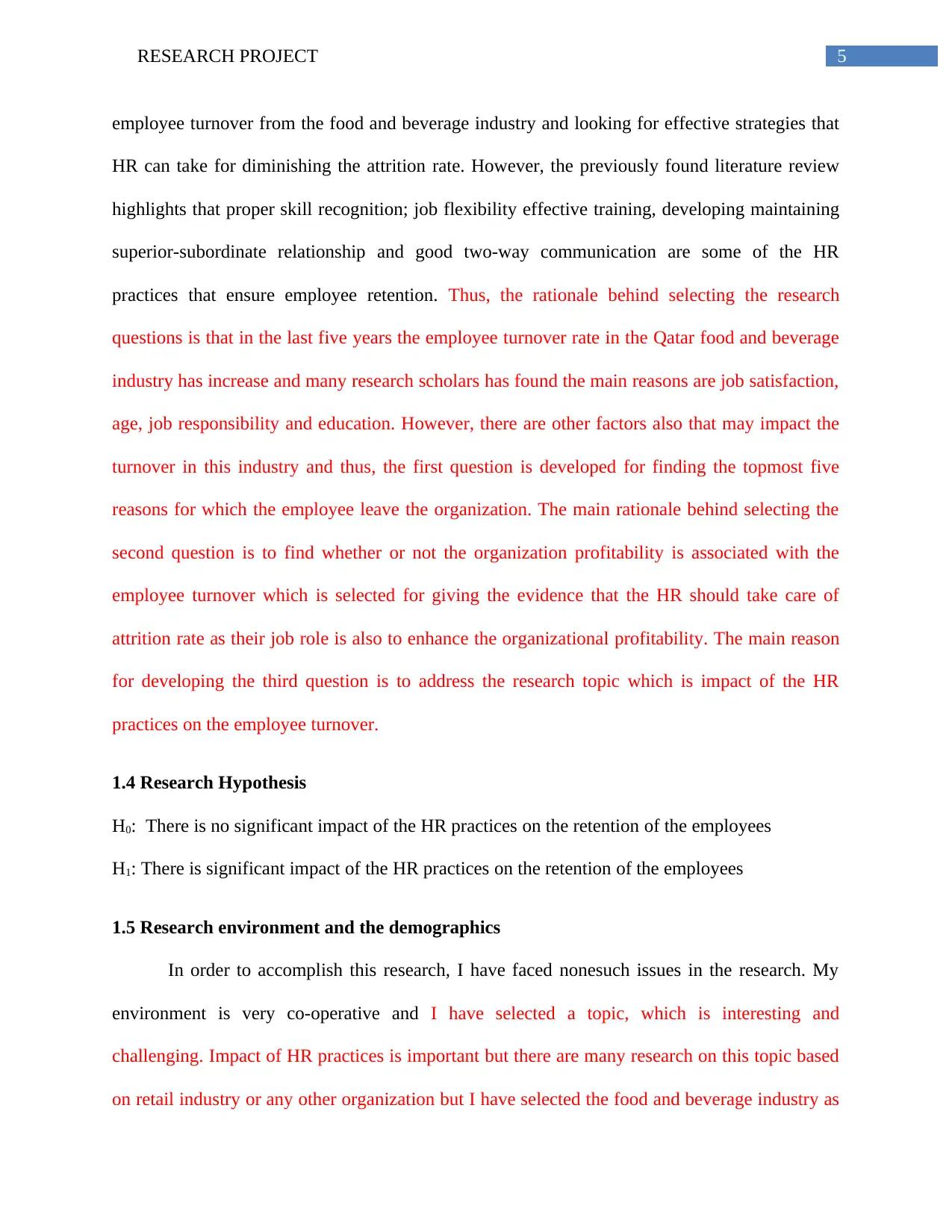
5RESEARCH PROJECT
employee turnover from the food and beverage industry and looking for effective strategies that
HR can take for diminishing the attrition rate. However, the previously found literature review
highlights that proper skill recognition; job flexibility effective training, developing maintaining
superior-subordinate relationship and good two-way communication are some of the HR
practices that ensure employee retention. Thus, the rationale behind selecting the research
questions is that in the last five years the employee turnover rate in the Qatar food and beverage
industry has increase and many research scholars has found the main reasons are job satisfaction,
age, job responsibility and education. However, there are other factors also that may impact the
turnover in this industry and thus, the first question is developed for finding the topmost five
reasons for which the employee leave the organization. The main rationale behind selecting the
second question is to find whether or not the organization profitability is associated with the
employee turnover which is selected for giving the evidence that the HR should take care of
attrition rate as their job role is also to enhance the organizational profitability. The main reason
for developing the third question is to address the research topic which is impact of the HR
practices on the employee turnover.
1.4 Research Hypothesis
H0: There is no significant impact of the HR practices on the retention of the employees
H1: There is significant impact of the HR practices on the retention of the employees
1.5 Research environment and the demographics
In order to accomplish this research, I have faced nonesuch issues in the research. My
environment is very co-operative and I have selected a topic, which is interesting and
challenging. Impact of HR practices is important but there are many research on this topic based
on retail industry or any other organization but I have selected the food and beverage industry as
employee turnover from the food and beverage industry and looking for effective strategies that
HR can take for diminishing the attrition rate. However, the previously found literature review
highlights that proper skill recognition; job flexibility effective training, developing maintaining
superior-subordinate relationship and good two-way communication are some of the HR
practices that ensure employee retention. Thus, the rationale behind selecting the research
questions is that in the last five years the employee turnover rate in the Qatar food and beverage
industry has increase and many research scholars has found the main reasons are job satisfaction,
age, job responsibility and education. However, there are other factors also that may impact the
turnover in this industry and thus, the first question is developed for finding the topmost five
reasons for which the employee leave the organization. The main rationale behind selecting the
second question is to find whether or not the organization profitability is associated with the
employee turnover which is selected for giving the evidence that the HR should take care of
attrition rate as their job role is also to enhance the organizational profitability. The main reason
for developing the third question is to address the research topic which is impact of the HR
practices on the employee turnover.
1.4 Research Hypothesis
H0: There is no significant impact of the HR practices on the retention of the employees
H1: There is significant impact of the HR practices on the retention of the employees
1.5 Research environment and the demographics
In order to accomplish this research, I have faced nonesuch issues in the research. My
environment is very co-operative and I have selected a topic, which is interesting and
challenging. Impact of HR practices is important but there are many research on this topic based
on retail industry or any other organization but I have selected the food and beverage industry as
⊘ This is a preview!⊘
Do you want full access?
Subscribe today to unlock all pages.

Trusted by 1+ million students worldwide
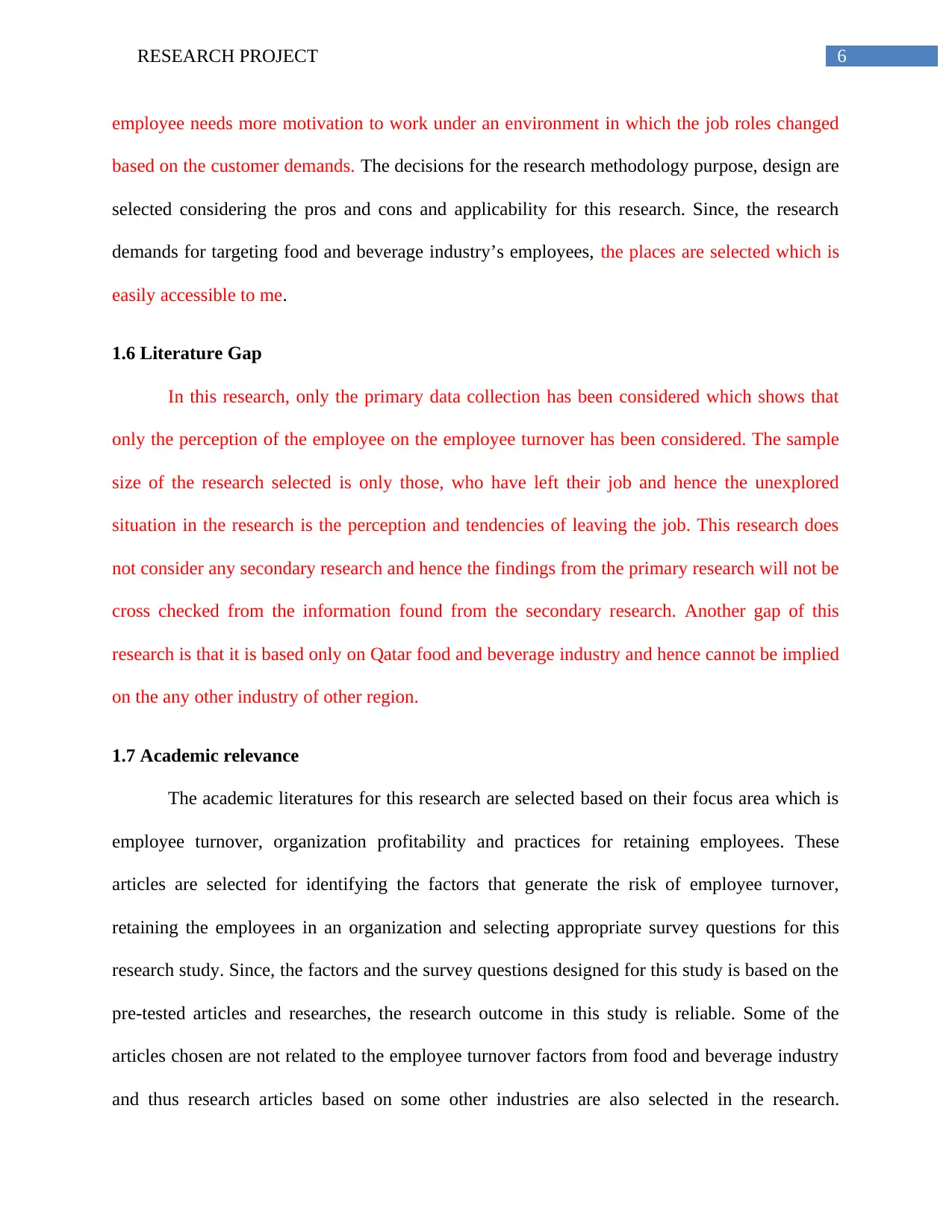
6RESEARCH PROJECT
employee needs more motivation to work under an environment in which the job roles changed
based on the customer demands. The decisions for the research methodology purpose, design are
selected considering the pros and cons and applicability for this research. Since, the research
demands for targeting food and beverage industry’s employees, the places are selected which is
easily accessible to me.
1.6 Literature Gap
In this research, only the primary data collection has been considered which shows that
only the perception of the employee on the employee turnover has been considered. The sample
size of the research selected is only those, who have left their job and hence the unexplored
situation in the research is the perception and tendencies of leaving the job. This research does
not consider any secondary research and hence the findings from the primary research will not be
cross checked from the information found from the secondary research. Another gap of this
research is that it is based only on Qatar food and beverage industry and hence cannot be implied
on the any other industry of other region.
1.7 Academic relevance
The academic literatures for this research are selected based on their focus area which is
employee turnover, organization profitability and practices for retaining employees. These
articles are selected for identifying the factors that generate the risk of employee turnover,
retaining the employees in an organization and selecting appropriate survey questions for this
research study. Since, the factors and the survey questions designed for this study is based on the
pre-tested articles and researches, the research outcome in this study is reliable. Some of the
articles chosen are not related to the employee turnover factors from food and beverage industry
and thus research articles based on some other industries are also selected in the research.
employee needs more motivation to work under an environment in which the job roles changed
based on the customer demands. The decisions for the research methodology purpose, design are
selected considering the pros and cons and applicability for this research. Since, the research
demands for targeting food and beverage industry’s employees, the places are selected which is
easily accessible to me.
1.6 Literature Gap
In this research, only the primary data collection has been considered which shows that
only the perception of the employee on the employee turnover has been considered. The sample
size of the research selected is only those, who have left their job and hence the unexplored
situation in the research is the perception and tendencies of leaving the job. This research does
not consider any secondary research and hence the findings from the primary research will not be
cross checked from the information found from the secondary research. Another gap of this
research is that it is based only on Qatar food and beverage industry and hence cannot be implied
on the any other industry of other region.
1.7 Academic relevance
The academic literatures for this research are selected based on their focus area which is
employee turnover, organization profitability and practices for retaining employees. These
articles are selected for identifying the factors that generate the risk of employee turnover,
retaining the employees in an organization and selecting appropriate survey questions for this
research study. Since, the factors and the survey questions designed for this study is based on the
pre-tested articles and researches, the research outcome in this study is reliable. Some of the
articles chosen are not related to the employee turnover factors from food and beverage industry
and thus research articles based on some other industries are also selected in the research.
Paraphrase This Document
Need a fresh take? Get an instant paraphrase of this document with our AI Paraphraser
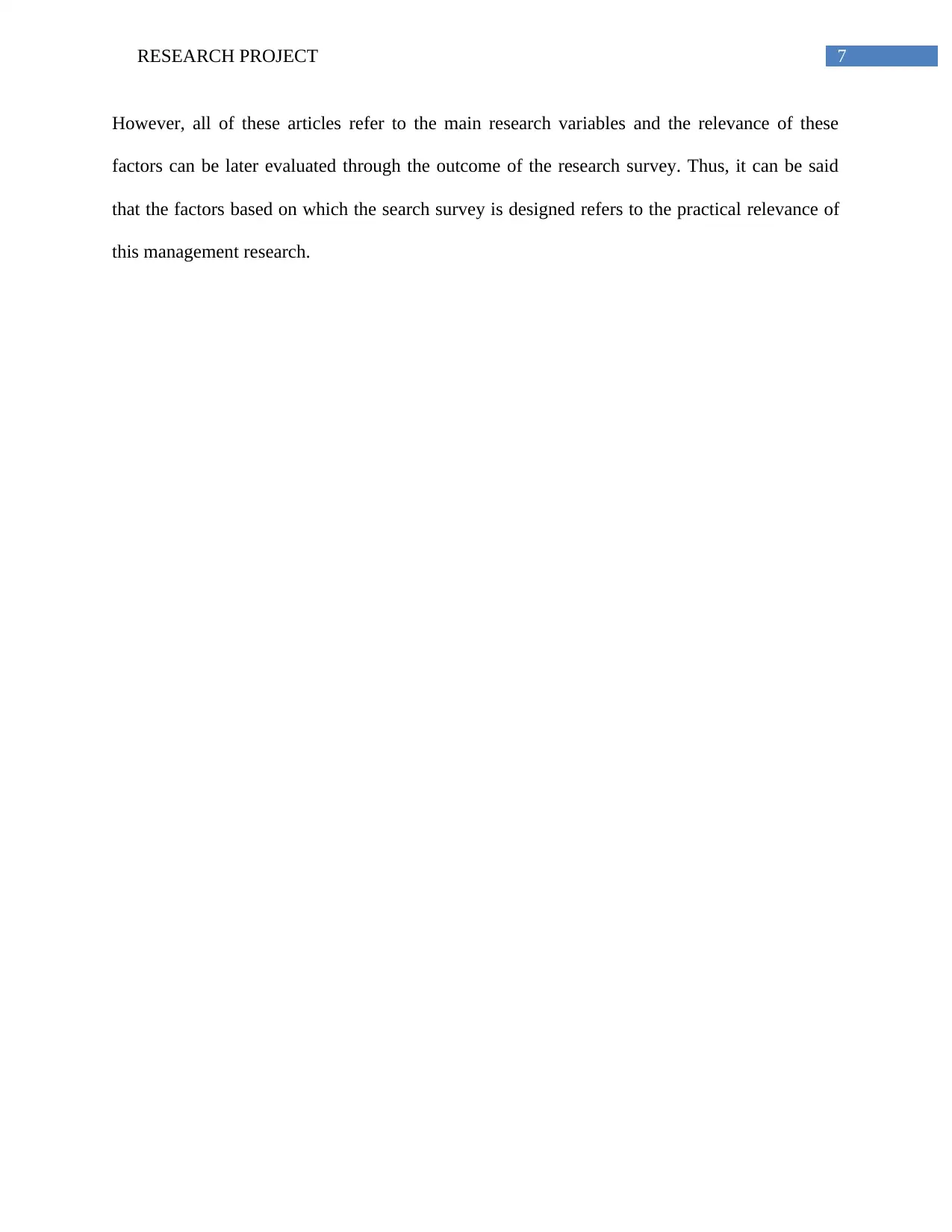
7RESEARCH PROJECT
However, all of these articles refer to the main research variables and the relevance of these
factors can be later evaluated through the outcome of the research survey. Thus, it can be said
that the factors based on which the search survey is designed refers to the practical relevance of
this management research.
However, all of these articles refer to the main research variables and the relevance of these
factors can be later evaluated through the outcome of the research survey. Thus, it can be said
that the factors based on which the search survey is designed refers to the practical relevance of
this management research.
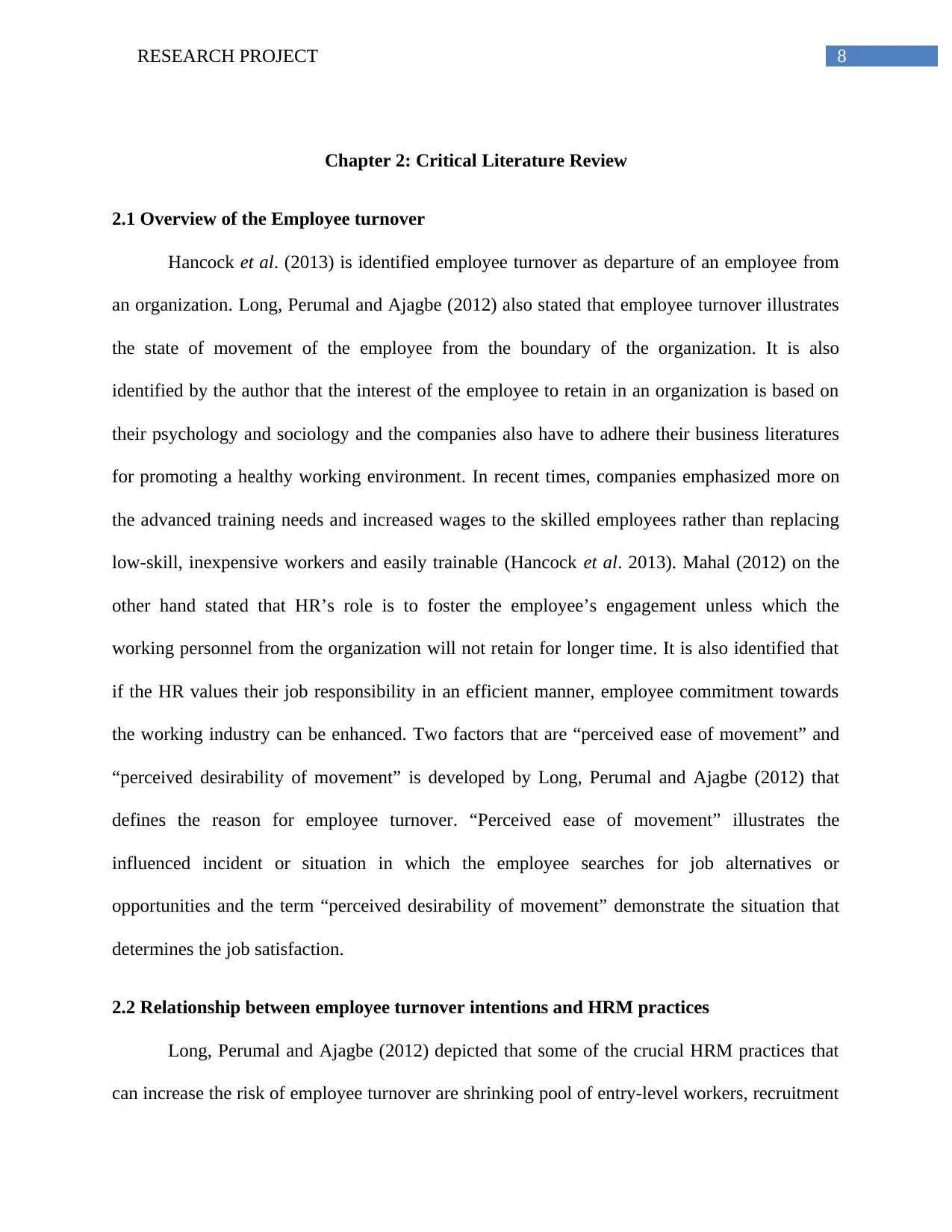
8RESEARCH PROJECT
Chapter 2: Critical Literature Review
2.1 Overview of the Employee turnover
Hancock et al. (2013) is identified employee turnover as departure of an employee from
an organization. Long, Perumal and Ajagbe (2012) also stated that employee turnover illustrates
the state of movement of the employee from the boundary of the organization. It is also
identified by the author that the interest of the employee to retain in an organization is based on
their psychology and sociology and the companies also have to adhere their business literatures
for promoting a healthy working environment. In recent times, companies emphasized more on
the advanced training needs and increased wages to the skilled employees rather than replacing
low-skill, inexpensive workers and easily trainable (Hancock et al. 2013). Mahal (2012) on the
other hand stated that HR’s role is to foster the employee’s engagement unless which the
working personnel from the organization will not retain for longer time. It is also identified that
if the HR values their job responsibility in an efficient manner, employee commitment towards
the working industry can be enhanced. Two factors that are “perceived ease of movement” and
“perceived desirability of movement” is developed by Long, Perumal and Ajagbe (2012) that
defines the reason for employee turnover. “Perceived ease of movement” illustrates the
influenced incident or situation in which the employee searches for job alternatives or
opportunities and the term “perceived desirability of movement” demonstrate the situation that
determines the job satisfaction.
2.2 Relationship between employee turnover intentions and HRM practices
Long, Perumal and Ajagbe (2012) depicted that some of the crucial HRM practices that
can increase the risk of employee turnover are shrinking pool of entry-level workers, recruitment
Chapter 2: Critical Literature Review
2.1 Overview of the Employee turnover
Hancock et al. (2013) is identified employee turnover as departure of an employee from
an organization. Long, Perumal and Ajagbe (2012) also stated that employee turnover illustrates
the state of movement of the employee from the boundary of the organization. It is also
identified by the author that the interest of the employee to retain in an organization is based on
their psychology and sociology and the companies also have to adhere their business literatures
for promoting a healthy working environment. In recent times, companies emphasized more on
the advanced training needs and increased wages to the skilled employees rather than replacing
low-skill, inexpensive workers and easily trainable (Hancock et al. 2013). Mahal (2012) on the
other hand stated that HR’s role is to foster the employee’s engagement unless which the
working personnel from the organization will not retain for longer time. It is also identified that
if the HR values their job responsibility in an efficient manner, employee commitment towards
the working industry can be enhanced. Two factors that are “perceived ease of movement” and
“perceived desirability of movement” is developed by Long, Perumal and Ajagbe (2012) that
defines the reason for employee turnover. “Perceived ease of movement” illustrates the
influenced incident or situation in which the employee searches for job alternatives or
opportunities and the term “perceived desirability of movement” demonstrate the situation that
determines the job satisfaction.
2.2 Relationship between employee turnover intentions and HRM practices
Long, Perumal and Ajagbe (2012) depicted that some of the crucial HRM practices that
can increase the risk of employee turnover are shrinking pool of entry-level workers, recruitment
⊘ This is a preview!⊘
Do you want full access?
Subscribe today to unlock all pages.

Trusted by 1+ million students worldwide
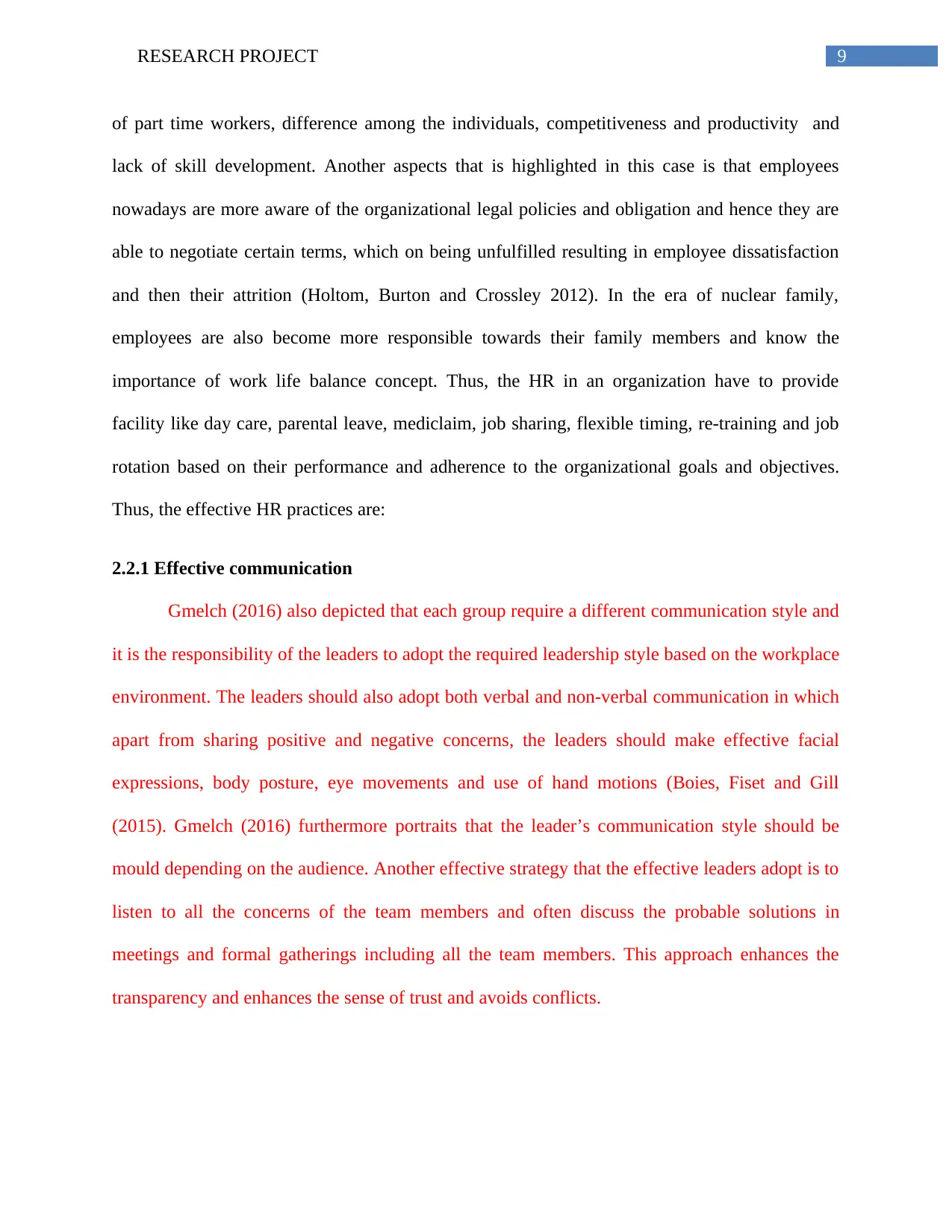
9RESEARCH PROJECT
of part time workers, difference among the individuals, competitiveness and productivity and
lack of skill development. Another aspects that is highlighted in this case is that employees
nowadays are more aware of the organizational legal policies and obligation and hence they are
able to negotiate certain terms, which on being unfulfilled resulting in employee dissatisfaction
and then their attrition (Holtom, Burton and Crossley 2012). In the era of nuclear family,
employees are also become more responsible towards their family members and know the
importance of work life balance concept. Thus, the HR in an organization have to provide
facility like day care, parental leave, mediclaim, job sharing, flexible timing, re-training and job
rotation based on their performance and adherence to the organizational goals and objectives.
Thus, the effective HR practices are:
2.2.1 Effective communication
Gmelch (2016) also depicted that each group require a different communication style and
it is the responsibility of the leaders to adopt the required leadership style based on the workplace
environment. The leaders should also adopt both verbal and non-verbal communication in which
apart from sharing positive and negative concerns, the leaders should make effective facial
expressions, body posture, eye movements and use of hand motions (Boies, Fiset and Gill
(2015). Gmelch (2016) furthermore portraits that the leader’s communication style should be
mould depending on the audience. Another effective strategy that the effective leaders adopt is to
listen to all the concerns of the team members and often discuss the probable solutions in
meetings and formal gatherings including all the team members. This approach enhances the
transparency and enhances the sense of trust and avoids conflicts.
of part time workers, difference among the individuals, competitiveness and productivity and
lack of skill development. Another aspects that is highlighted in this case is that employees
nowadays are more aware of the organizational legal policies and obligation and hence they are
able to negotiate certain terms, which on being unfulfilled resulting in employee dissatisfaction
and then their attrition (Holtom, Burton and Crossley 2012). In the era of nuclear family,
employees are also become more responsible towards their family members and know the
importance of work life balance concept. Thus, the HR in an organization have to provide
facility like day care, parental leave, mediclaim, job sharing, flexible timing, re-training and job
rotation based on their performance and adherence to the organizational goals and objectives.
Thus, the effective HR practices are:
2.2.1 Effective communication
Gmelch (2016) also depicted that each group require a different communication style and
it is the responsibility of the leaders to adopt the required leadership style based on the workplace
environment. The leaders should also adopt both verbal and non-verbal communication in which
apart from sharing positive and negative concerns, the leaders should make effective facial
expressions, body posture, eye movements and use of hand motions (Boies, Fiset and Gill
(2015). Gmelch (2016) furthermore portraits that the leader’s communication style should be
mould depending on the audience. Another effective strategy that the effective leaders adopt is to
listen to all the concerns of the team members and often discuss the probable solutions in
meetings and formal gatherings including all the team members. This approach enhances the
transparency and enhances the sense of trust and avoids conflicts.
Paraphrase This Document
Need a fresh take? Get an instant paraphrase of this document with our AI Paraphraser
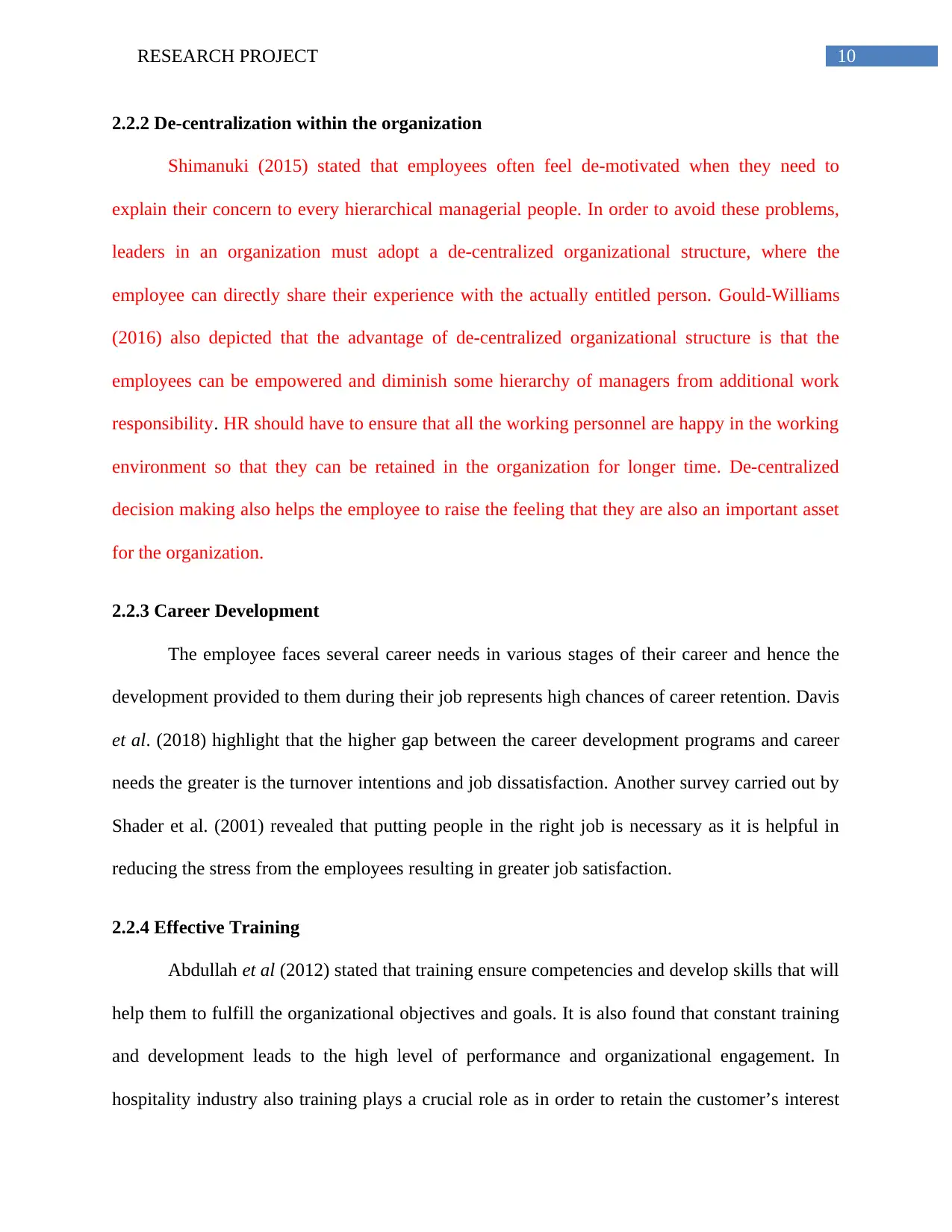
10RESEARCH PROJECT
2.2.2 De-centralization within the organization
Shimanuki (2015) stated that employees often feel de-motivated when they need to
explain their concern to every hierarchical managerial people. In order to avoid these problems,
leaders in an organization must adopt a de-centralized organizational structure, where the
employee can directly share their experience with the actually entitled person. Gould-Williams
(2016) also depicted that the advantage of de-centralized organizational structure is that the
employees can be empowered and diminish some hierarchy of managers from additional work
responsibility. HR should have to ensure that all the working personnel are happy in the working
environment so that they can be retained in the organization for longer time. De-centralized
decision making also helps the employee to raise the feeling that they are also an important asset
for the organization.
2.2.3 Career Development
The employee faces several career needs in various stages of their career and hence the
development provided to them during their job represents high chances of career retention. Davis
et al. (2018) highlight that the higher gap between the career development programs and career
needs the greater is the turnover intentions and job dissatisfaction. Another survey carried out by
Shader et al. (2001) revealed that putting people in the right job is necessary as it is helpful in
reducing the stress from the employees resulting in greater job satisfaction.
2.2.4 Effective Training
Abdullah et al (2012) stated that training ensure competencies and develop skills that will
help them to fulfill the organizational objectives and goals. It is also found that constant training
and development leads to the high level of performance and organizational engagement. In
hospitality industry also training plays a crucial role as in order to retain the customer’s interest
2.2.2 De-centralization within the organization
Shimanuki (2015) stated that employees often feel de-motivated when they need to
explain their concern to every hierarchical managerial people. In order to avoid these problems,
leaders in an organization must adopt a de-centralized organizational structure, where the
employee can directly share their experience with the actually entitled person. Gould-Williams
(2016) also depicted that the advantage of de-centralized organizational structure is that the
employees can be empowered and diminish some hierarchy of managers from additional work
responsibility. HR should have to ensure that all the working personnel are happy in the working
environment so that they can be retained in the organization for longer time. De-centralized
decision making also helps the employee to raise the feeling that they are also an important asset
for the organization.
2.2.3 Career Development
The employee faces several career needs in various stages of their career and hence the
development provided to them during their job represents high chances of career retention. Davis
et al. (2018) highlight that the higher gap between the career development programs and career
needs the greater is the turnover intentions and job dissatisfaction. Another survey carried out by
Shader et al. (2001) revealed that putting people in the right job is necessary as it is helpful in
reducing the stress from the employees resulting in greater job satisfaction.
2.2.4 Effective Training
Abdullah et al (2012) stated that training ensure competencies and develop skills that will
help them to fulfill the organizational objectives and goals. It is also found that constant training
and development leads to the high level of performance and organizational engagement. In
hospitality industry also training plays a crucial role as in order to retain the customer’s interest
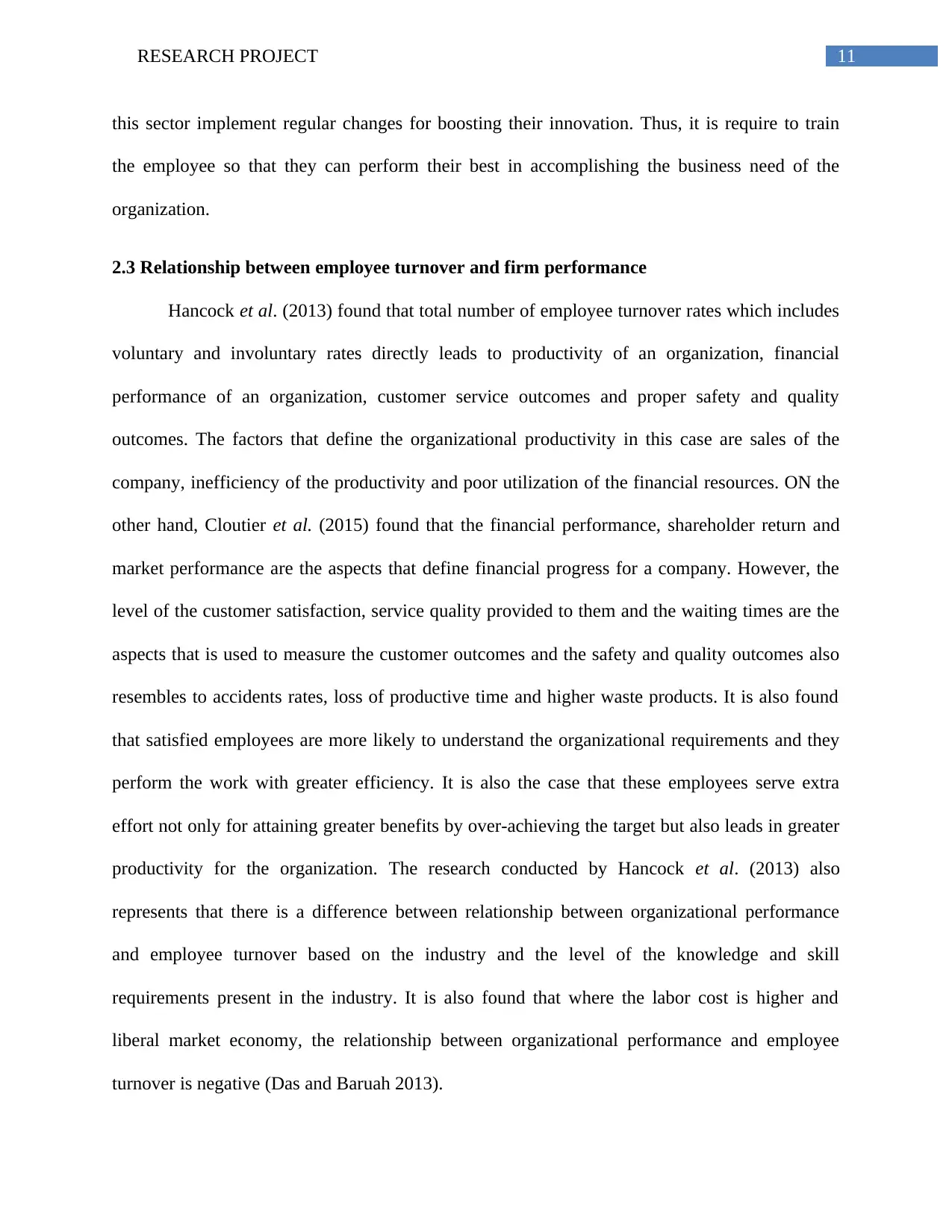
11RESEARCH PROJECT
this sector implement regular changes for boosting their innovation. Thus, it is require to train
the employee so that they can perform their best in accomplishing the business need of the
organization.
2.3 Relationship between employee turnover and firm performance
Hancock et al. (2013) found that total number of employee turnover rates which includes
voluntary and involuntary rates directly leads to productivity of an organization, financial
performance of an organization, customer service outcomes and proper safety and quality
outcomes. The factors that define the organizational productivity in this case are sales of the
company, inefficiency of the productivity and poor utilization of the financial resources. ON the
other hand, Cloutier et al. (2015) found that the financial performance, shareholder return and
market performance are the aspects that define financial progress for a company. However, the
level of the customer satisfaction, service quality provided to them and the waiting times are the
aspects that is used to measure the customer outcomes and the safety and quality outcomes also
resembles to accidents rates, loss of productive time and higher waste products. It is also found
that satisfied employees are more likely to understand the organizational requirements and they
perform the work with greater efficiency. It is also the case that these employees serve extra
effort not only for attaining greater benefits by over-achieving the target but also leads in greater
productivity for the organization. The research conducted by Hancock et al. (2013) also
represents that there is a difference between relationship between organizational performance
and employee turnover based on the industry and the level of the knowledge and skill
requirements present in the industry. It is also found that where the labor cost is higher and
liberal market economy, the relationship between organizational performance and employee
turnover is negative (Das and Baruah 2013).
this sector implement regular changes for boosting their innovation. Thus, it is require to train
the employee so that they can perform their best in accomplishing the business need of the
organization.
2.3 Relationship between employee turnover and firm performance
Hancock et al. (2013) found that total number of employee turnover rates which includes
voluntary and involuntary rates directly leads to productivity of an organization, financial
performance of an organization, customer service outcomes and proper safety and quality
outcomes. The factors that define the organizational productivity in this case are sales of the
company, inefficiency of the productivity and poor utilization of the financial resources. ON the
other hand, Cloutier et al. (2015) found that the financial performance, shareholder return and
market performance are the aspects that define financial progress for a company. However, the
level of the customer satisfaction, service quality provided to them and the waiting times are the
aspects that is used to measure the customer outcomes and the safety and quality outcomes also
resembles to accidents rates, loss of productive time and higher waste products. It is also found
that satisfied employees are more likely to understand the organizational requirements and they
perform the work with greater efficiency. It is also the case that these employees serve extra
effort not only for attaining greater benefits by over-achieving the target but also leads in greater
productivity for the organization. The research conducted by Hancock et al. (2013) also
represents that there is a difference between relationship between organizational performance
and employee turnover based on the industry and the level of the knowledge and skill
requirements present in the industry. It is also found that where the labor cost is higher and
liberal market economy, the relationship between organizational performance and employee
turnover is negative (Das and Baruah 2013).
⊘ This is a preview!⊘
Do you want full access?
Subscribe today to unlock all pages.

Trusted by 1+ million students worldwide
1 out of 24
Related Documents
Your All-in-One AI-Powered Toolkit for Academic Success.
+13062052269
info@desklib.com
Available 24*7 on WhatsApp / Email
![[object Object]](/_next/static/media/star-bottom.7253800d.svg)
Unlock your academic potential
Copyright © 2020–2025 A2Z Services. All Rights Reserved. Developed and managed by ZUCOL.




